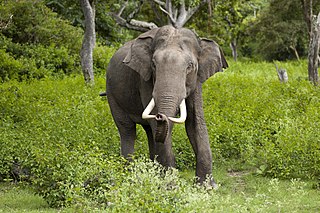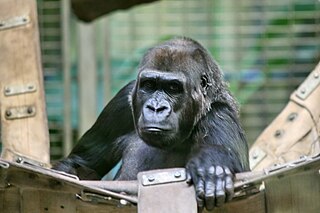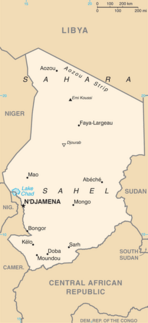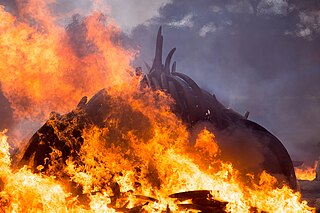
Ivory is a hard, white material from the tusks and teeth of animals, that consists mainly of dentine, one of the physical structures of teeth and tusks. The chemical structure of the teeth and tusks of mammals is the same, regardless of the species of origin. The trade in certain teeth and tusks other than elephant is well established and widespread; therefore, "ivory" can correctly be used to describe any mammalian teeth or tusks of commercial interest which are large enough to be carved or scrimshawed. It has been valued since ancient times in art or manufacturing for making a range of items from ivory carvings to false teeth, fans, dominoes and joint tubes. Elephant ivory is the most important source, but ivory from mammoth, walrus, hippopotamus, sperm whale, killer whale, narwhal and wart hog are used as well. Elk also have two ivory teeth, which are believed to be the remnants of tusks from their ancestors.

Poaching has been defined as the illegal hunting or capturing of wild animals, usually associated with land use rights.

The African forest elephant is a forest-dwelling species of elephant found in the Congo Basin. It is the smallest of the three extant species of elephant, but still one of the largest living terrestrial animals. The African forest elephant and the African bush elephant, L. africana, were considered to be one species until genetic studies indicated that they separated an estimated 2–7 million years ago. From an estimated population size of over 2 million prior to the colonization of Africa, the population in 2015 is estimated to be about 100,000 forest elephants, mostly living in the forests of Gabon. Due to a slower birth rate, the forest elephant takes longer to recover from poaching, which caused its population to fall by 65% from 2002 to 2014.

Vulcan Inc. is a privately held company controlled by the estate of late Microsoft co-founder Paul Allen. Established in 1986, Vulcan Inc. is headquartered on Fifth Avenue in Seattle, Washington. Vulcan oversees Allen's business activities and philanthropic efforts including —the Seattle Seahawks, the Portland Trail Blazers, the Great Elephant Census, the Seattle Cinerama, and Stratolaunch Systems.

Zakouma National Park is a 1,158-square-mile (3,000 km2) national park in southeastern Chad's Salamat Region. Zakouma is the nation's oldest national park, declared a national park in 1963 by presidential decree, giving it the highest form of protection available under the nation's laws. It has been managed by the nonprofit conservation organization African Parks since 2010 in partnership with Chad's government.

Garamba National Park is a nearly 2,000-square-mile (5,200 km2) national park in north-eastern Democratic Republic of the Congo. It is among Africa's oldest parks, and has been designated a World Heritage Site by UNESCO. Garamba has been managed by African Parks in cooperation with the Institut Congolais pour la Conservation de la Nature (ICCN), since 2005.

Environmental issues in Kenya include deforestation, soil erosion, desertification, water shortage and degraded water quality, flooding, poaching, and domestic and industrial pollution.

The Indian elephant is one of three extant recognized subspecies of the Asian elephant and native to mainland Asia.
Iain Douglas-Hamilton is a zoologist known for his study of elephants. He earned both a BSc in biology and a D.Phil. in zoology from Oriel College, Oxford, and he is the recipient of the 2010 Indianapolis Prize for his work on elephant conservation. His chief research interest is to understand elephant choices by studying their movements. In 1993, he founded the organisation Save the Elephants. He is a frequent keynote speaker at the annual Wildlife Conservation Network expo.

Nkhotakota Wildlife Reserve, is the largest and oldest wildlife reserve in Malawi, near Nkhotakota. The park's hilly terrain features dambos and miombo woodlands as the dominant vegetation, which support a variety of mammal and bird species. Poaching has greatly reduced the number of elephants and other large mammals in Nkhotakota, but conservation efforts to restore the elephant population started when African Parks began managing the reserve in 2015.

The African bush elephant, also known as the African savanna elephant, is the larger of the two species of African elephants, and the largest living terrestrial animal. These elephants were previously regarded as the same species, but the African forest elephant has been reclassified as L. cyclotis.

The ivory trade is the commercial, often illegal trade in the ivory tusks of the hippopotamus, walrus, narwhal, mammoth, and most commonly, African and Asian elephants.

Wildlife in the Central African Republic is in the vast natural habitat located between the Congo Basin's rain forests and large savannas, where the human density was smaller than 0.5 per km2 prior to 1850. The forest area of 22.755 million has, considered as one of the richest storehouses of wild life spread over national parks, hunting reserves and community hunting areas, underwent a change over to an alarming situation of loss of wild life due to greed for ivory and bushmeat exploitation by the hunters, mostly Arab slavers from across the borders of the Central African Republic with Chad and Sudan.

Elephant hunting or elephant poaching and exploitation of the ivory trade are illegal in Chad and pose a major threat to elephant populations. The profitable ivory industry is also a threat to the lives of rangers, even in the national parks, such as Zakouma National Park, the worst-affected area.
Jim Nyamu, of Nairobi, Kenya, is an elephant research scientist and activist against poaching and trade in ivory. Nyamu is the executive director at the Elephant Neighbors Center (ENC) and is leader of the movement, Ivory Belongs to Elephants. He has also held positions at the African Conservation Centre and Kenya Wildlife Service. The ENC is a grass-roots collaborative and participatory research organization focused on enhancing the capacity of communities living with wildlife to promote interlinkages between species and their habitats.

World Elephant Day is an international annual event on August 12, dedicated to the preservation and protection of the world's elephants. Conceived in 2011 by Canadian filmmakers Patricia Sims and Michael Clark of Canazwest Pictures, and Sivaporn Dardarananda, Secretary-General of the Elephant Reintroduction Foundation in Thailand, it was officially founded, supported and launched by Patricia Sims and the Elephant Reintroduction Foundation on August 12, 2012. Since that time, Patricia Sims continues to lead and direct World Elephant Day, which is now supported by over 65 wildlife organizations and many individuals in countries across the globe.

The destruction of ivory is a technique used by governments and conservation groups to deter the poaching of elephants for their tusks and to suppress the illegal ivory trade. As of 2016, more than 263 tonnes (580,000 lb) of ivory has been destroyed, typically by burning or crushing, in these high-profile events in 21 countries around the world. Kenya held the first event in 1989, as well as the largest event in 2016, when a total of 105 tonnes (231,000 lb) of ivory were incinerated.

Species affected by poaching refers both to the effects of illegal hunting and fishing or capturing of wild animals on certain species, and, in a recent usage, the illegal harvesting of wild plant species. The article provides an overview of species currently endangered or impaired by poaching in the Americas, sub-Saharan Africa, and South-East Asia.
Chinko, also known as Chinko Nature Reserve and the Chinko Project Area, is a protected area in the Central African Republic. The nonprofit conservation organization African Parks began managing Chinko in partnership with the government of the Central African Republic in December 2014.
























